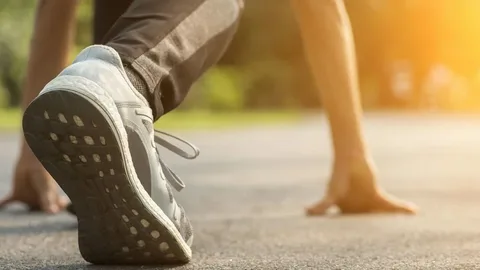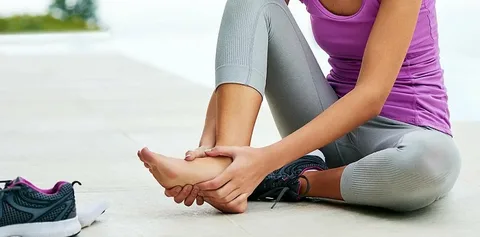Do you suffer from bone spurs? If so, you know how uncomfortable and painful they can be. Fortunately, certain shoes are designed to provide relief and make walking easier. In this blog post, will look at the best shoes for bone spurs, their features, and how they can help ease discomfort. So, if you’re looking for relief from your bone spurs, read on to learn more about the perfect shoes for you!
What Are Bone Spurs?
Bone spurs, or osteophytes, are bony growths on the edges of bones. They usually develop in response to the wear and tear of aging or due to certain conditions, such as osteoarthritis. While bone spurs can occur in various parts of the body, they commonly affect the feet, especially the heels and toes.
These spurs can be painful and lead to discomfort, especially when walking or standing for long periods. The extra bone can cause irritation and inflammation in the surrounding tissues, resulting in pain and stiffness.
Symptoms Of Bone Spurs
Bone spurs can cause a range of symptoms, which can vary depending on their location and size. The most common symptom is pain, which can be sharp or dull and may worsen with activity. This pain is typically localized to the affected area, such as the heel or toe. The pain can sometimes radiate to other parts of the foot or even the leg.
Another common symptom of bone spurs is stiffness. The extra bone growth can restrict the movement of nearby joints, making it difficult to bend or flex the affected area. This stiffness can make walking or performing everyday tasks challenging and uncomfortable.
How Shoes Can Help With Bone Spurs
When it comes to finding relief for your bone spurs, the right shoes can make all the difference. Certain shoes are designed to alleviate discomfort and make walking easier for individuals suffering from bone spurs. But how exactly can shoes help with this condition?
First and foremost, shoes for bone spurs provide proper cushioning and support. The extra padding and shock absorption can help alleviate the pressure and impact on your feet, reducing pain and discomfort. Look for shoes with cushioned insoles and supportive midsoles to provide optimal comfort.
Allows For Better Alignment And Reduces Friction
Shoes for bone spurs often have a wider toe box and ample arch support. The wider toe box allows for better alignment and reduces friction and pressure on your toes, while the arch support helps distribute weight evenly across your foot, relieving strain on the affected areas.
Moreover, some shoes for bone spurs feature specialized features such as heel cups or gel inserts. These provide targeted support and cushioning to the heel, where bone spurs commonly occur. These shoes can greatly alleviate discomfort and pain by reducing pressure and friction on the heel.
Characteristics Of Shoes To Look For
When searching for the best shoes to ease the discomfort of bone spurs, there are several key characteristics to look for. Firstly, opt for shoes with excellent cushioning and support. This will help to alleviate pressure and reduce the impact on your feet, providing much-needed relief.
Additionally, consider shoes with a wider toe box and ample arch support. The wider toe box allows for better alignment and reduces friction and pressure on your toes, while the arch support helps distribute weight evenly across your foot, relieving strain on the affected areas.
Provide Targeted Support And Cushioning
Specialized features like heel cups or gel inserts can also be beneficial. These provide targeted support and cushioning to the heel, where bone spurs commonly occur. These shoes can greatly alleviate discomfort and pain by reducing pressure and friction on the heel.
Another important factor to consider is the material of the shoes. Look for shoes made from breathable and lightweight materials that allow proper airflow to keep your feet cool and comfortable. Overall, the best shoes for bone spurs combine cushioning, support, and specialized features to provide relief and comfort.
Types Of Shoes For Different Activities
When finding the perfect shoes for bone spurs, it’s important to consider the specific activities you engage in daily. Different activities require different types of shoes, and choosing the right pair can greatly alleviate discomfort and make movement easier. Here are some recommendations for shoes based on different activities:
Walking
If you enjoy walking for exercise or leisure, look for shoes that provide excellent cushioning and support. Walking shoes with thick, shock-absorbing soles and ample arch support can help reduce the impact on your feet and minimize pain.
Running
For those who enjoy running, investing in a pair of running shoes designed specifically for individuals with bone spurs is crucial. These shoes typically have extra cushioning in the heel area to alleviate pressure on the bone spurs and provide optimal shock absorption.
Work
If you must be on your feet for long, look for shoes with excellent arch support and cushioning. Additionally, consider shoes with a slip-resistant outsole to prevent accidents and ensure stability.
Sports
If you participate in sports activities like basketball or tennis, choose shoes that provide ample ankle support and stability. Look for high-top sneakers with cushioned insoles to protect your feet and minimize discomfort.
Tips For Finding The Right Shoe For Your Needs
Finding the right shoes to ease the discomfort of bone spurs can make a difference in your daily life. Here are some helpful tips to guide you in your search for the perfect pair:
- Get the right fit: When trying on shoes, ensure they fit properly. Look for shoes with enough room in the toe box to accommodate any swelling or irritation caused by bone spurs. Remember, comfort is key!
- Look for ample cushioning: Cushioning is crucial for alleviating pressure and reducing impact on your feet. Opt for shoes with cushioned insoles and supportive midsoles to provide optimal comfort and shock absorption.
- Consider adjustable features: Some shoes come with adjustable straps or laces, allowing you to customize the fit according to your needs. This can be especially beneficial if you have swelling or require additional support in certain areas.
- Prioritize arch support: Look for shoes with ample arch support to distribute weight evenly across your foot and relieve strain on the affected areas. This can help reduce discomfort and improve overall stability.
- Choose breathable materials: Shoes made from breathable and lightweight materials can help keep your feet cool and comfortable, especially if you spend long periods on your feet.
The Role Of Orthotics
Orthotics, or orthopedic shoe inserts, play a significant role in relieving individuals suffering from bone spurs. These specialized inserts are designed to provide support, alignment, and cushioning to the feet, helping to alleviate discomfort and reduce the impact on the affected areas.
One of the key benefits of orthotics is their ability to redistribute weight and pressure across the foot. By providing additional support and cushioning, orthotics help to reduce the strain on the bone spurs, allowing for better mobility and improved comfort.
Cost-Effective Option
Orthotics can be custom-made or purchased over-the-counter, depending on your specific needs. Custom-made orthotics are created based on the individual’s foot shape and gait pattern, providing personalized support. On the other hand, over-the-counter orthotics are pre-made and can be a more cost-effective option for those with milder symptoms.
It is important to consult with a healthcare professional or a podiatrist to determine the type of orthotics most beneficial for your specific condition. They can assess your feet, recommend appropriate orthotics, and ensure they are properly fitted.
Getting Creative With Shoe Inserts
When finding relief for your bone spurs, sometimes you must get creative. While there are many great shoe options designed specifically for this condition, you can also take additional measures to make walking even more comfortable. One such measure is the use of shoe inserts.
Shoe inserts, insoles or orthotics, can be a game-changer for individuals suffering from bone spurs. These inserts can provide extra support, cushioning, and even additional features to target specific areas of discomfort.
One creative option is silicone gel inserts. These inserts are soft, flexible, and provide excellent shock absorption. They can be placed directly in your shoes to help cushion your feet and reduce the impact on the affected areas.
Inserts Mold To The Shape Of Your Foot
Another option is using memory foam inserts. These inserts mold to the shape of your foot, providing customized support and comfort. The memory foam contours to your unique foot shape, offering targeted cushioning where you need it most. They can be especially beneficial for individuals with specific areas of discomfort, such as the heel or arch.
You can also try using heel cups or cushions. These inserts provide additional support and cushioning for the heel, where bone spurs commonly occur. They help to reduce pressure and friction on the affected area, providing instant relief.
FAQs
1. Are There Specific Shoe Brands That Are Best For Bone Spurs?
While there isn’t one brand that suits everyone with bone spurs, some brands are known for their comfort and support features. Popular brands to consider include New Balance, Brooks, ASICS, and Hoka One One.
2. Can I Use Orthotics In Any Type Of Shoe?
Yes, orthotics can be used in most shoes, as long as there is enough room to accommodate the inserts. Look for shoes with removable insoles or enough depth to accommodate orthotics.
3. Can I Wear High Heels If I Have Bone Spurs?
It is generally not recommended to wear high heels if you have bone spurs, as they can exacerbate pain and discomfort. High heels can increase pressure on the feet and toes, leading to further irritation and inflammation.
4. How Often Should I Replace My Shoes If I Have Bone Spurs?
Shoes generally last around 300-500 miles of walking or 6-12 months, depending on usage and wear. However, if you have bone spurs, it’s important to regularly assess the condition of your shoes.
5. Can Exercises Help With Bone Spurs?
While exercises may not directly treat bone spurs, they can help improve flexibility, strength, and mobility, alleviating some discomfort.
Conclusion
In conclusion, finding the right shoes for bone spurs can ease your discomfort and make walking easier. By prioritizing comfort, cushioning, and support, you can find shoes that relieve your specific needs. Look for shoes with cushioned insoles, supportive midsoles, wide toe boxes, and ample arch support to alleviate pressure and distribute weight evenly. Additionally, specialized features like heel cups or gel inserts can provide targeted support and cushioning to the affected areas. It’s also important to consider the specific activities you engage in daily and choose shoes accordingly. Whether you enjoy walking, running, working, or playing sports, shoes are designed to minimize pain and discomfort for each activity.



